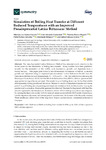Mostrar o rexistro simple do ítem
Simulation of Boiling Heat Transfer at Different Reduced Temperatures with an Improved Pseudopotential Lattice Boltzmann Method
| dc.contributor.author | Guzella, Matheus dos Santos | |
| dc.contributor.author | Czelusniak, Luiz Eduardo | |
| dc.contributor.author | Mapelli, Vinicius Pessoa | |
| dc.contributor.author | Fariñas Alvariño, Pablo | |
| dc.contributor.author | Ribatski, Gherhardt | |
| dc.contributor.author | Cabezas Gómez, Luben | |
| dc.date.accessioned | 2020-09-30T17:17:43Z | |
| dc.date.available | 2020-09-30T17:17:43Z | |
| dc.date.issued | 2020-07 | |
| dc.identifier.citation | Guzella, M.d.S.; Czelusniak, L.E.; Mapelli, V.P.; Alvariño, P.F.; Ribatski, G.; Cabezas-Gómez, L. Simulation of Boiling Heat Transfer at Different Reduced Temperatures with an Improved Pseudopotential Lattice Boltzmann Method. Symmetry 2020, 12, 1358. https://doi.org/10.3390/sym12081358 | |
| dc.identifier.issn | 2073-8994 | |
| dc.identifier.uri | http://hdl.handle.net/2183/26276 | |
| dc.description.abstract | [Abstract] The pseudopotential Lattice Boltzmann Method has attracted much attention in the recent years for the simulation of boiling heat transfer. Many studies have been published recently for the simulation of the bubble cycle (nucleation, growth and departure from a heated surface). This paper puts forward two-dimensional simulations of bubble nucleation, growth and departure using an improved pseudopotential Lattice Boltzmann Model from the literature at different reduced temperatures, Tr=0.76 and Tr=0.86. Two different models using the Bhatnagar–Gross–Krook (BGK) and the Multiple-Relaxation-Time (MRT) collision operators with appropriate forcing schemes are used. The results for pool boiling show that the bubbles exhibit axial symmetry during growth and departure. Numerical results of departure diameter and release period for pool boiling are compared against empirical correlations from the literature by varying the gravitational acceleration. Reasonable agreement is observed. Nucleate boiling trends with heat flux are also captured by the simulations. Numerical results of flow boiling simulations are compared by varying the Reynolds number for both reduced temperatures with the MRT model. It was found that the departure diamenter and release period decreases with the increase of the Reynolds number. These results are a direct effect of the drag force. Proper conclusions are commented at the end of the paper. | es_ES |
| dc.description.sponsorship | Brasil. Conselho Nacional de Desenvolvimento Científico e Tecnológico; 304972/2017-7 | es_ES |
| dc.description.sponsorship | Brasil. Coordenação de aperfeiçoamento de pessoal de nivel superior; 001 | |
| dc.description.sponsorship | Fundação de Amparo à Pesquisa do Estado de São Paulo; 2016/09509-1 | |
| dc.description.sponsorship | Fundação de Amparo à Pesquisa do Estado de São Paulo; 2018/09041-5 | |
| dc.description.sponsorship | All the authors fully acknowledge the support provided by CNPq (National Council for Scientific and Technological Development, process 304972/2017-7), CAPES (Coordination for the Improvement of Higher Education Personnel, Finance Code 001) and FAPESP (São Paulo Foundation for Research Support, 2016/09509-1 and 2018/09041-5). | |
| dc.language.iso | eng | es_ES |
| dc.publisher | MDPI | es_ES |
| dc.relation.uri | https://doi.org/10.3390/sym12081358 | es_ES |
| dc.rights | Atribución 4.0 Internacional (CC BY 4.0) | es_ES |
| dc.rights.uri | https://creativecommons.org/licenses/by/4.0/ | * |
| dc.subject | Lattice Boltzmann Method | |
| dc.subject | Boiling heat transfer | |
| dc.subject | Bubble cycle | |
| dc.subject | BGK collision operator | |
| dc.subject | MRT collision operator | |
| dc.title | Simulation of Boiling Heat Transfer at Different Reduced Temperatures with an Improved Pseudopotential Lattice Boltzmann Method | es_ES |
| dc.type | info:eu-repo/semantics/article | es_ES |
| dc.rights.access | info:eu-repo/semantics/openAccess | es_ES |
| UDC.journalTitle | Symmetry | es_ES |
| UDC.volume | 12 | es_ES |
| UDC.issue | 8 | es_ES |
| dc.identifier.doi | 10.3390/sym12081358 |
Ficheiros no ítem
Este ítem aparece na(s) seguinte(s) colección(s)
-
GI-SISTER - Artigos [35]






